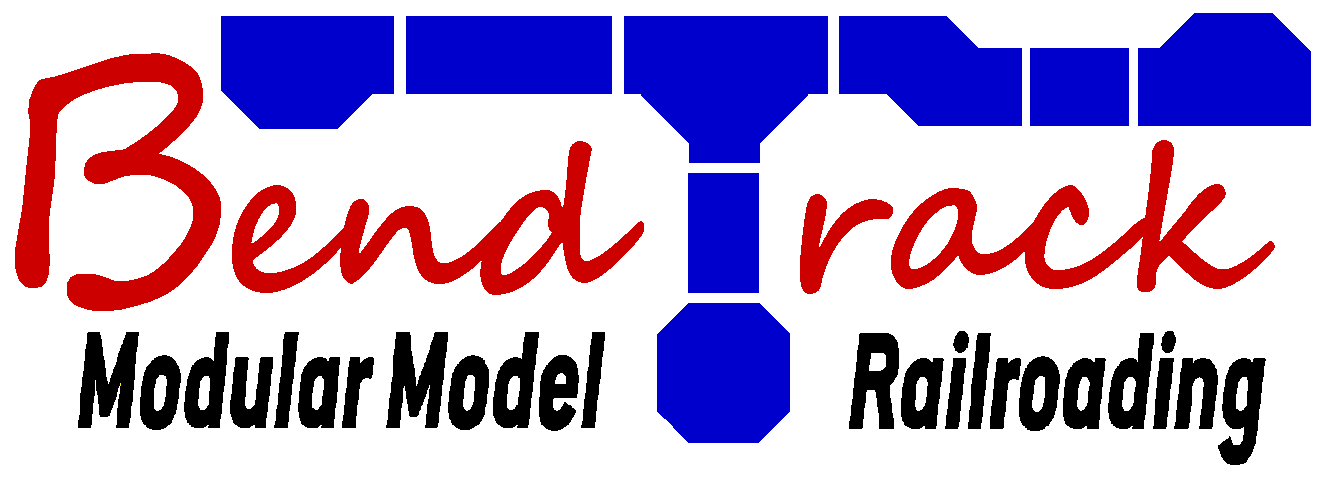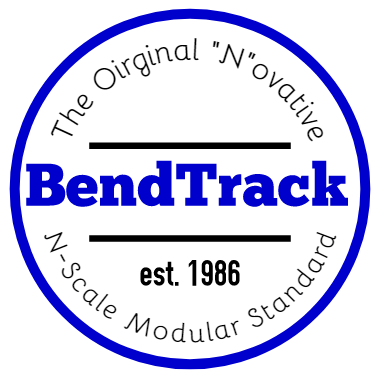Copyright © 2018 by Andrew Reid - BendTrack · All Rights reserved · E-Mail: andrew@bendtrack.com
The Home of BendTrack
The BendTrack Manual -- Advantages & Concerns
Advantages of BendTrack
Designed & Hosted by JunctionDesign
No Operating Pit
With no fixed number of modules required (other than two balloons) and with countless different sizes, shapes, and
configurations of modules being possible, there is an almost limitless variety of possible combinations to layout design. In fact,
each operating session or show can yield a new variation in the design of how the modules are arranged.
Also, since you don't need to match lengths of one part of a display with lengths of other parts as in traditional modular
systems, you won't have to leave out anyone's modules just because the lengths don't work out to be equal.
Flexibility
An Interactive Layout
The BendTrack system was created foremost with the idea that it could give a home or club layout the capacity for
movement to a new or better location and second, that it could be used for shows. With the proper use of stanchions or guard
rails at shows, we've found that you can walk around the layout while keeping an eye on your train and at the same time interact
with the people who are viewing the trains.
From earlier experiences with traditional modular layouts, it seemed almost as if the modules acted as a barrier between
the club members and the public. We were perceived as being inside a sound proof control booth, not to be contacted unless
we happened to stray outside the system. Even as early as our first show with BendTrack modules, the general public was more
inclined to visit with our members and ask questions about model railroading as a whole. We found our BendTrack layout to be
an excellent way for our club members to reach out and interact with spectators and train enthusiasts who might be thinking of
getting into the hobby or perhaps joining a club.
More 'Running' In A Given Space
Since BendTrack does not have an
operating pit, you can use angled, curved
and branching modules to make the most
of the available space. Especially when
using branching modules, the layout
display can place modules into locations
that would normally be left vacant with
nothing for the club members to run on or
the public to see. More modules can be
used in the same square footage, meaning
more mainline to run on and more trains
running at once. This has allowed us not to
have "running time" problems from lack of
usable space in a given area, while also
lending to the more "realistic" feel of the
trains actually going to and from
somewhere, rather than just round in
circles.
Reduced Start-Up Expenses
BendTrack offers the possibility of
using just two balloon modules to be able
to have an operating layout. The lesser
amount of modules will reduce the cost of
construction, so you might say that you get
two for the price of one. For instance, a
member who builds two balloon modules
would accomplish the same end result as if
they had built four traditional 90 degree
corner modules, but with one half the time
and expense.
This minimal amount of modules to
start a small system would fit nicely with a
club who's membership is small but wishes
to have a larger layout in the future, as well
as to aid in growing a clubs membership,
as the cost to construct a simple straight
module is minimal but can become a part
of a much larger layout during an Open
House or Train Show.
Concerns
The fact that the BendTrack system, in comparison with traditional modular layouts, has no enclosed operating pit might
bring up the concern for adequate security during shows and ease of movement between different parts of the layout. This issue
can be addressed with ease...we've found that the recommended height of ~50 inches (rather than the more typical 36 to 40
inch height of typical modular layouts) helps to eliminate the need for an operating pit.
The use of an increased height results in not only the ability to move under the modules if desired, but also provides a
much more realistic viewing angle for both operators and spectators. We have also found this height to be more comfortable in
terms of working on scenery and rolling stock. As far as security goes, we have found that with shelving (which rests on the
module leg cross pieces) and skirting (on each side of a module covering this shelving) there is ample room to store boxes and
other rift raft out of view of the public. Additionally, stanchions and rope around the layout would provide additional protection
from young arms and hands that may want to touch the trains.
Of course, given the flexibility of BendTrack, it is entirely possible to configure the layout in such a way that a portion of the
layout can be "closed off" to the public, giving the group a more private area for a table & chairs, storage, or whatever they may
need.
Tighter Minimum Curve Radius
While it's true that BendTrack does have a tighter minimum track radius (14-1/2") than usually affiliated with other modular
systems, this does not mean that all of your curved track must stay at this minimum. Curves can be as broad as you wish and
branch lines that curve off the two mainlines can be as tight as you find practical for the use of your branch line.
On the original three modules that we built, the two balloons were built with the minimum radius allowed (a 29" diameter).
We have consistently run trains with four locomotives and 65 to 70 cars with minimal problems. We've found that for the most
part the problems have been wheel or car related, rather than track radius related.
Of course, the best rule of thumb for curve radius is to have as large a curve radius as you possibly can. A nice long
passenger train or that hotshot intermodal are going to look a lot more realistic on a balloon with sweeping 22" radius curve than
they are on a 14.5" minimum radius balloon.
The Original "N"ovative Modular System

Home
The Manual
Whats New?
History
Tips & Tricks
Links
Photo Gallery
Clubs & Groups
Support Us
Contact Us
Advantages of BendTrack
With no fixed number of modules
required (other than two balloons) and with
countless different sizes, shapes, and
configurations of modules being possible,
there is an almost limitless variety of
possible combinations to layout design. In
fact, each operating session or show can
yield a new variation in the design of how
the modules are arranged.
Also, since you don't need to match
lengths of one part of a display with lengths
of other parts as in traditional modular
systems, you won't have to leave out
anyone's modules just because the lengths
don't work out to be equal.
The BendTrack system was created foremost with the idea that it could give a
home or club layout the capacity for movement to a new or better location and second,
that it could be used for shows. With the proper use of stanchions or guard rails at
shows, we've found that you can walk around the layout while keeping an eye on your
train and at the same time interact with the people who are viewing the trains.
From earlier experiences with traditional modular layouts, it seemed almost as if
the modules acted as a barrier between the club members and the public. We were
perceived as being inside a sound proof control booth, not to be contacted unless we
happened to stray outside the system. Even as early as our first show with BendTrack
modules, the general public was more inclined to visit with our members and ask
questions about model railroading as a whole. We found our BendTrack layout to be an
excellent way for our club members to reach out and interact with spectators and train
enthusiasts who might be thinking of getting into the hobby or perhaps joining a club.
Since BendTrack does not have an operating pit, you can use angled, curved and
branching modules to make the most of the available space. Especially when using
branching modules, the layout display can place modules into locations that would
normally be left vacant with nothing for the club members to run on or the public to see.
More modules can be used in the same square footage, meaning more mainline to run
on and more trains running at once. This has allowed us not to have "running time"
problems from lack of usable space in a given area, while also lending to the more
"realistic" feel of the trains actually going to and from somewhere, rather than just round
in circles.
BendTrack offers the possibility of using just two balloon modules to be able to have an operating layout. The lesser
amount of modules will reduce the cost of construction, so you might say that you get two for the price of one. For instance, a
member who builds two balloon modules would accomplish the same end result as if they had built four traditional 90 degree
corner modules, but with one half the time and expense.
This minimal amount of modules to start a small system would fit nicely with a club who's membership is small but wishes
to have a larger layout in the future, as well as to aid in growing a clubs membership, as the cost to construct a simple straight
module is minimal but can become a part of a much larger layout during an Open House or Train Show.
Concerns
No Operating Pit
The fact that the BendTrack system, in comparison with traditional modular layouts,
has no enclosed operating pit might bring up the concern for adequate security during
shows and ease of movement between different parts of the layout. This issue can be
addressed with ease...we've found that the recommended height of ~50 inches (rather
than the more typical 36 to 40 inch height of typical modular layouts) helps to eliminate
the need for an operating pit.
The use of an increased height results in not only the ability to move under the
modules if desired, but also provides a much more realistic viewing angle for both
operators and spectators. We have also found this height to be more comfortable in
terms of working on scenery and rolling stock. As far as security goes, we have found
that with shelving (which rests on the module leg cross pieces) and skirting (on each
side of a module covering this shelving) there is ample room to store boxes and other rift
raft out of view of the public. Additionally, stanchions and rope around the layout would
provide additional protection from young arms and hands that may want to touch the
trains.
Of course, given the flexibility of BendTrack, it is entirely possible to configure the
layout in such a way that a portion of the layout can be "closed off" to the public, giving
the group a more private area for a table & chairs, storage, or whatever they may need.
While it's true that BendTrack does have a tighter minimum track radius (14-1/2")
than usually affiliated with other modular systems, this does not mean that all of your
curved track must stay at this minimum. Curves can be as broad as you wish and branch
lines that curve off the two mainlines can be as tight as you find practical for the use of
your branch line.
On the original three modules that we built, the two balloons were built with the
minimum radius allowed (a 29" diameter). We have consistently run trains with four
locomotives and 65 to 70 cars with minimal problems. We've found that for the most part
the problems have been wheel or car related, rather than track radius related.
Of course, the best rule of thumb for curve radius is to have as large a curve radius
as you possibly can. A nice long passenger train or that hotshot intermodal are going to
look a lot more realistic on a balloon with sweeping 22" radius curve than they are on a
14.5" minimum radius balloon.
The Original "N"ovative
Modular System
Modular System
Advantages of BendTrack
With no fixed number of modules required (other than two balloons) and with countless different sizes, shapes, and
configurations of modules being possible, there is an almost limitless variety of possible combinations to layout design. In fact,
each operating session or show can yield a new variation in the design of how the modules are arranged.
Also, since you don't need to match lengths of one part of a display with lengths of other parts as in traditional modular
systems, you won't have to leave out anyone's modules just because the lengths don't work out to be equal.
With no fixed number of modules required (other than two balloons) and with
countless different sizes, shapes, and configurations of modules being possible, there is
an almost limitless variety of possible combinations to layout design. In fact, each
operating session or show can yield a new variation in the design of how the modules
are arranged.
Also, since you don't need to match lengths of one part of a display with lengths of
other parts as in traditional modular systems, you won't have to leave out anyone's
modules just because the lengths don't work out to be equal.
The BendTrack system was created
foremost with the idea that it could give a
home or club layout the capacity for
movement to a new or better location and
second, that it could be used for shows.
With the proper use of stanchions or guard
rails at shows, we've found that you can
walk around the layout while keeping an
eye on your train and at the same time
interact with the people who are viewing
the trains.
From earlier experiences with
traditional modular layouts, it seemed
almost as if the modules acted as a barrier
between the club members and the public.
We were perceived as being inside a
sound proof control booth, not to be
contacted unless we happened to stray
outside the system. Even as early as our
first show with BendTrack modules, the
general public was more inclined to visit
with our members and ask questions about
model railroading as a whole. We found
our BendTrack layout to be an excellent
way for our club members to reach out and
interact with spectators and train
enthusiasts who might be thinking of
getting into the hobby or perhaps joining a
club.
Concerns
BendTrack offers the possibility of using just two balloon modules to be able to
have an operating layout. The lesser amount of modules will reduce the cost of
construction, so you might say that you get two for the price of one. For instance, a
member who builds two balloon modules would accomplish the same end result as if
they had built four traditional 90 degree corner modules, but with one half the time and
expense.
This minimal amount of modules to start a small system would fit nicely with a club
who's membership is small but wishes to have a larger layout in the future, as well as to
aid in growing a clubs membership, as the cost to construct a simple straight module is
minimal but can become a part of a much larger layout during an Open House or Train
Show.
Concerns
The fact that the BendTrack system,
in comparison with traditional modular
layouts, has no enclosed operating pit
might bring up the concern for adequate
security during shows and ease of
movement between different parts of the
layout. This issue can be addressed with
ease...we've found that the recommended
height of ~50 inches (rather than the more
typical 36 to 40 inch height of typical
modular layouts) helps to eliminate the
need for an operating pit.
The use of an increased height
results in not only the ability to move under
the modules if desired, but also provides a
much more realistic viewing angle for both
operators and spectators. We have also
found this height to be more comfortable in
terms of working on scenery and rolling
stock. As far as security goes, we have
found that with shelving (which rests on the
module leg cross pieces) and skirting (on
each side of a module covering this
shelving) there is ample room to store
boxes and other rift raft out of view of the
public. Additionally, stanchions and rope
around the layout would provide additional
protection from young arms and hands that
may want to touch the trains.
Of course, given the flexibility of
BendTrack, it is entirely possible to
configure the layout in such a way that a
portion of the layout can be "closed off" to
the public, giving the group a more private
area for a table & chairs, storage, or
whatever they may need.
While it's true that BendTrack does
have a tighter minimum track radius (14-
1/2") than usually affiliated with other
modular systems, this does not mean that
all of your curved track must stay at this
minimum. Curves can be as broad as you
wish and branch lines that curve off the two
mainlines can be as tight as you find
practical for the use of your branch line.
On the original three modules that we
built, the two balloons were built with the
minimum radius allowed (a 29" diameter).
We have consistently run trains with four
locomotives and 65 to 70 cars with minimal
problems. We've found that for the most
part the problems have been wheel or car
related, rather than track radius related.
Of course, the best rule of thumb for
curve radius is to have as large a curve
radius as you possibly can. A nice long
passenger train or that hotshot intermodal
are going to look a lot more realistic on a
balloon with sweeping 22" radius curve
than they are on a 14.5" minimum radius
balloon.

Click Logo to go to the Top of the Page
Copyright © 2018 by Andrew Reid - BendTrack
All Rights reserved
E-Mail: andrew@bendtrack.com
All Rights reserved
E-Mail: andrew@bendtrack.com

